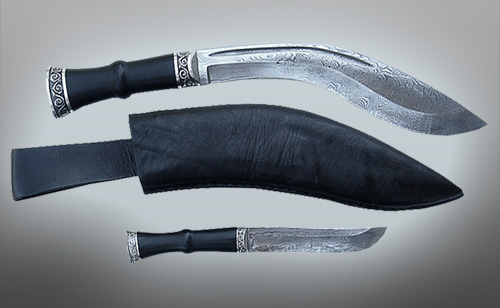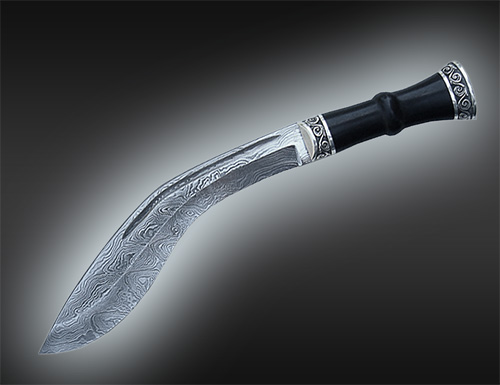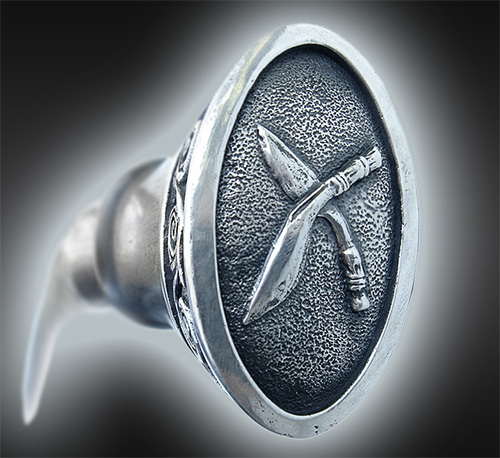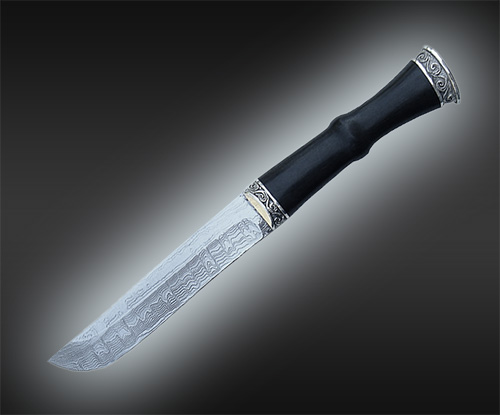- +38 066 411-51-45
Hunting set based on kukri
 Starting to update the range of knives, I turned to the topic of traditional knives from different nations of the world.
Starting to update the range of knives, I turned to the topic of traditional knives from different nations of the world.
It was very interesting to work with the Nepalese theme of kukri, but it is not interesting to copy traditional products. I decided to adapt it to hunting conditions in our climate. The process of making kukri for me began with the selection of metal. Then I formed a blade. A distinctive feature of the kukra is the "humpback" butt of the end of the blade, inclined at an angle of 20 to 40 (rarely up to 50) to the line of the handle. It should be noted that the part of the blade adjacent to the handle has a slight inclination to its axis - up to 7 °. Smoothly rounded butt is called "henshi". The blade of the kukra has a characteristic profile of the "falcon's wing" with sharpening on the concave edge (ie it is a knife with the so-called back bend).
This bending provides the blade with unique working properties: the blow inflicted by the "belly" of the blade is both chopping and cutting, which provides convenience and speed of cutting strong and elastic low-growing mountain wood. The rather thick obushok which turns a knife kukri into a hybrid of a heavy knife and an ax is subordinated to the same purpose.
Features of the shape of kukri knives
The shape of the large kukri knife, which has a total length of about 400 mm in thickness along the butt at the base of about 12 mm, is as close as possible to traditional models.
The initial shape of the workpiece is forged according to the template, taking into account the shape and thickness of the blade. For the basis! a product from a private collection was taken. However, in the homeland of kukri they are made from 250 mm to 1 meter long and the shape of the blade of each master is different. clearer faces, which are also edges of hardness.
The purpose of the narrow valley at the rear of the blade is the same.
The knife itself is unique in shape. It is forged from a whole piece like this !, So that its blade, unlike a sword or scythe, is curved into another! side. It is believed that this unique bend increases the force of the blow inflicted by a skillful hand, seventeen times!
 The center of gravity of the kukra is shifted closer to the handle.
The center of gravity of the kukra is shifted closer to the handle.
If you rotate the brush with a knife, it seems that the curls will definitely break out of your hand and fly away.
In short, this weapon is not for amateurs.
I made some changes to the treatment of the knife, removing the traditional religious motifs - Shiva's tooth, Shiva's eye and Shiva's sword.
In traditional kukri, each characteristic element has both practical and symbolic significance. For example, the groove in the butt is often mistaken for blood flow, in fact, it is designed to increase the damping properties and stiffness of the blade both when chopping and when hitting the butt.
This groove is called the "Sword of Shiva" and gives the kukri the power of the weapon of the god Shiva.
The notch on the blade in the handle is called "kaudi", "kaura" or "cho" and comes in different shapes, and usually means a trident (or Shiva's tooth) - the main attribute and symbol of the power of this god. Another form of cho - "cow's footprint", is a symbol of the goddess Kali (cow is a sacred animal in Hinduism). It is believed that Shiva's tooth is designed to relieve internal stress in the metal that occurs at the beginning of the sample on the blade. But then it would be possible to make such cuts on all blades, in which the "cut" (down in the form of a concave lens) does not start from the handle itself, but has a heel.
Metallurgists believe that this sample is designed to prevent the development of cracks and therefore is performed at the place of concentration of maximum stresses, where the blade passes into the unsharpened heel. The practical meaning is to prevent the formation of cracks and chipping of the handle blade.
The blade with variable sharpening angle gives maximum efficiency in chopping, cutting and prickly blows and symbolizes the Sun and the Moon - the traditional symbols of Nepal.
Special hardening
The blade of a traditional kukri has not only sharpening with a variable angle, but also zone hardening. Butt blade! much softer than the edges of the blade. For kukri are characterized by hardness of 25-27 HRC in the butt, 46-48 1 HRC in the middle of the blade and 55-57 HRC in the edges of the blade or 57-58 HRC in the butt and about 60 HRC at the edge of the blade. To maintain the elasticity of the blade at such a high hardness helps the traditional forging technique, passed down from generation to generation by Nepalese blacksmiths.
The metal hat on the head of the "eye of Shiva" symbolizes the all-seeing eye of the god, and in practical terms closes the tip of the shank of the blade, which runs through the entire handle, and allows you to use the handle of the kukri as a hammer.
The shank of my kukri can withstand heavy loads, which allows you to use it both as an ax and as a machete.
Rings on the handle provide! confident holding the kukra in a wet hand and symbolize the levels of the universe.
Making my changes, I made kukri with one protruding ring instead of a few small rings. This shape of the handle, which has a protruding ring in the central part and, closer to the top, a conical shape, allows you to keep the cuckoos in different types of work, including cutting branches without straining the brush.
 The knife is easy to hold
The knife is easy to hold
The shape of the handle is very convenient when working with this knife. I chose this shape because with any grip, the ring is between the index and middle fingers, or between the middle and ring fingers. Fixation in the hand is amazing, the guard is resting.
When I finished making the handle, I soaked it in linseed oil. After soaking, I dried the handle (it took several days) and polished it with a felt disk with natural wax.
I used silver casting of traditional Nepalese ornaments.
Motifs for ornaments were found with great difficulty. It turned out that national craftsmen do not spoil their customers with a variety of decorative finishes. On the top of a large knife depicts two crossed cuckoos, such a finish is quite common in the traditional design of Nepalese products.
Materials
To make kukri I used Damascus, silver (about 150 grams), ebony.
Delicate is a wooden frame covered with leather.
Quite often the vagina is equipped with a pair of additional items (karda and chakmak).
Karda - a knife with a blade length of about 30 mm.
Chakmak - a knife used for sharpening and straightening kukra; the blade of this knife has greater hardness than the blade of the doll, which allows you to use it to restore the cutting properties of the doll. Chakmak can also be used as a scraper, pliers, screwdrivers and even a flint: in the old days, an additional bag was added to the cucumber's vagina for everyday trifles, including silicon and tinder.
Малий ніж
To make the kukri more familiar to our hunters, I made changes to the small auxiliary knife. Its size was increased.
In our conditions, working with a knife that has such a short blade is not convenient. And our hunter is not used to such a length of knife.
Therefore, in a small knife, I made the length of the blade about 120 mm, and the handle - about 110 mm.
The second knife was removed altogether, because the modern steels used in the manufacture of Damascus allow you to work with the cockroach for a long time without fixing the blade.
Drawing on Damascus tried to find a unique way to give the product an ancient ethnic flavor.
Kukri made by me can be cut and cut with equal ease, which is facilitated by the variable sharpening angle of the blade and its curved shape on the contrary. The blow inflicted by the "belly" of the blade, as already mentioned, is both chopping and cutting.
This specific design will allow the hunter to perform a lot of work in the field with this knife.
Kukri is convenient to chop, cut. The stability of the cutting edge is quite satisfactory, when chopping wood (from poplar to larch), the blade does not sit down at all. A dry stick about 40-50 mm thick is cut with one blow. If the stick is thick, it takes a few strokes.
Testing knives
- It cuts very well.
- During the tests for the experiment, I planed a few bars. Not as convenient as a regular knife, but possible. However, you must first get used to the specific curvature of the blade.
- Cuts ropes, opens cans.
- I haven't tried to dig yet.
- The handle sits comfortably in the hand. No contact with metal (except rivets), so you can use in the cold. When chopping the handle does not loosen, sits as if poured. He does not bend his hand. The ring is securely fixed to the hand during the injection and cut, no guard is required.
Kukri is a perfect marching knife.
Once you get used to it, you will use it more often than anyone else! tool.
In Nepal, Kukri knives are not only used for military purposes. For the vast majority! Nepalese kukri is a common rural tool used to clear areas of vegetation, gutter, slaughter livestock, process meat and perform other household tasks. In addition, kukry is a tool for pastoralists and travelers, overcoming passes and rapid rivers.
In our conditions kukri is quite an acceptable tourist option! or a hunting knife.


